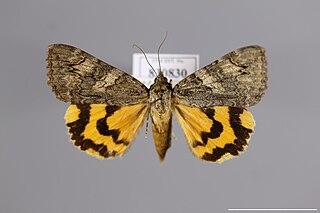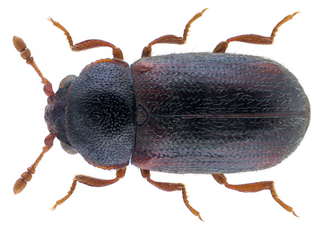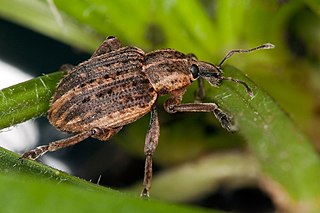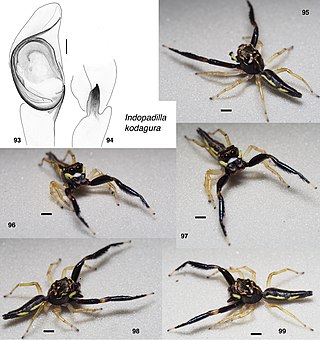
Weevils are beetles belonging to the superfamily Curculionoidea, known for their elongated snouts. They are usually small – less than 6 mm in length – and herbivorous. Approximately 97,000 species of weevils are known. They belong to several families, with most of them in the family Curculionidae. It also includes bark beetles, which while morphologically dissimilar to other weevils in lacking the distinctive snout, is a subfamily of Curculionidae. Some other beetles, although not closely related, bear the name "weevil", such as the biscuit weevil, which belongs to the family Ptinidae.

Belidae is a family of weevils, called belids or primitive weevils because they have straight antennae, unlike the "true weevils" or Curculionidae which have geniculate (elbowed) antennae. They are sometimes known as "cycad weevils", but this properly refers to a few species from the genera Parallocorynus and Rhopalotria.
Panachraesta is a monotypic genus of Sri Lankan jumping spiders containing the single species, Panachraesta paludosa. It was first described by Eugène Louis Simon in 1900, and is only found in Sri Lanka. Until 2016, it was a synonym of Myrmarachne.
Thianitara is a genus of Southeast Asian jumping spiders that was first described by Eugène Louis Simon in 1903. As of August 2019 it contains only two species, found in Thailand, Indonesia, and Malaysia: T. spectrum and T. thailandica. It was briefly considered a junior synonym of Thiania until 2017, when it was revived by Jerzy Prószyński.

The Entiminae are a large subfamily in the weevil family Curculionidae, containing most of the short-nosed weevils, including such genera as Entimus, Otiorhynchus, Phyllobius, Sitona, and Pachyrrhynchus. In comparison with their stunning diversity, only a few of these weevils are notorious pests of major economic importance. Entimines are commonly encountered in the field, including urban environments, and abundant in entomological collections.

Catocala helena is a moth of the family Erebidae. It is found in Siberia and Manchuria.

Sphindidae is a family of beetles, in the suborder Polyphaga. They are called slime mold beetles due to their exclusive feeding on slime molds during adult and larval stages, other aspects of their life history are obscure. Palaeontological discoveries since 2015 have added to the geologic history of Sphindidae, including the discovery of Libanopsis, placed in the extinct subfamily Libanopsinae.

Donus is a genus of true weevils in the tribe Hyperini.
Hermosa is a genus of jumping spiders first described by G. W. Peckham and E. G. Peckham in 1892, and synonymized with Myrmarachne in 1901. In 2016, Jerzy Prószyński split up Myrmarachne, creating nine new genera, all with names beginning "Myrm". However, it turned out that Myrmavola volatilis, the type species of Myrmavola, was also the type species of Hermosa, and Myrmavola was made a junior synonym. It is part of the Myrmarachnini tribe within the Salticoida clade of Salticinae.
Orcevia is a genus of Asian jumping spiders first described by Tamerlan Thorell in 1890. Laufeia, circumscribed to include Orcevia, is placed in the tribe Euophryini in the Salticoida clade of Salticinae. It was once considered a synonym of Laufeia, but it was revalidated in 2019.
Junxattus is a monotypic genus of southeast Asian jumping spiders native to Sumatra. It contains the single species, Junxattus daiqini, first described by Jerzy Prószyński and Christa Deeleman-Reinhold in 2012. The genus was placed in the subfamily Euophryinae, the equivalent of the tribe Euophryini.
Lechia is a small genus of Asian jumping spiders first described by Marek Michal Zabka in 1985. As of March 2022 it contains only two species: L. minuta and L. squamata.

Attinella is a genus of North American jumping spiders. It was first described by Nathan Banks in 1905 based on the type species Attinella dorsata. As of March 2022 it contains only three species: A. concolor, A. dorsata, and A. juniperi. It was synonymized with Sitticus from 1979 to 2017, when the genus Sittiab was split from Sitticus by Prószyński in 2017, and Attinella was recognized as its senior synonym.
Padillothorus is a genus of jumping spiders in the family Salticidae containing the single species, Padillothorus elegans. It was first described by Jerzy Prószyński in 2018, and has only been found in Indonesia.

Indopadilla is a genus of jumping spiders first described by J. T. D. Caleb, P. M. Sankaran and K. S. Nafin in 2019. It was placed into the tribe Baviini in the Salticoida clade of Salticinae. Several species have been transferred from the genus Bavia.

Rhaebus is a genus of metallic bean weevils in the subfamily Bruchinae, and the only member of the tribe Rhaebini. It is restricted to the Palearctic region.

Rhaebus gebleri is a species of bean weevil in the tribe Rhaebini. This species was described by Gotthelf Fischer von Waldheim in 1824, and is the type species of the genus Rhaebus.

Aberrasine is a genus of Erebid moths, first described by Volynkin and Huang in 2019.











